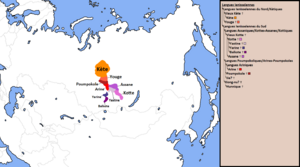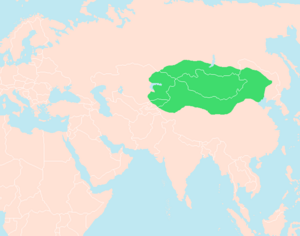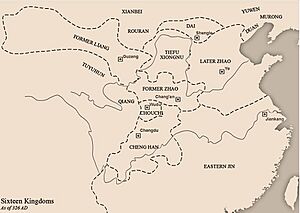Yeniseian languages facts for kids
Quick facts for kids Yeniseian |
|
|---|---|
| Ethnicity: | Yeniseian people |
| Geographic distribution: |
today along the Yenisei River historically large parts of Siberia and of Mongolia |
| Linguistic classification: | Dené–Yeniseian?
|
| Proto-language: | Proto-Yeniseian |
| Subdivisions: |
Ketic
Pumpokolic †
Arinic †
Kottic †
|
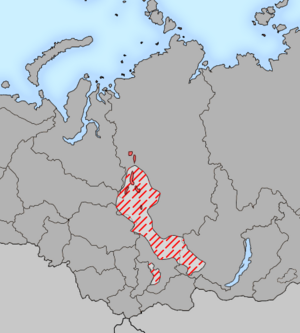 Distribution of Yeniseian languages in the 17th century (hatched) and in the end of 20th century (solid). Hydronymic data suggests that this distribution represents a northward migration of original Yeniseian populations from the Sayan Mountains and northern Mongolia.
|
|
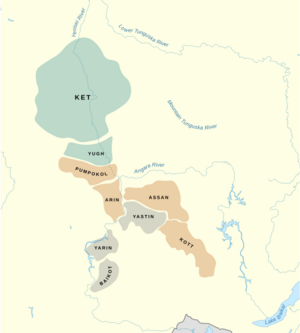 The distribution of individual Yeniseian languages in 1600
|
|
The Yeniseian languages are a group of languages. They are spoken by the Yeniseian people. These people live near the Yenisei River in central Siberia.
Scientists believe Yeniseian languages might be connected to languages in North America. This idea is part of a bigger theory called the Dené–Yeniseian language family. If true, it would show a link between languages from the "Old World" (like Siberia) and the "New World" (like North America). Today, only one Yeniseian language is still spoken: Ket.
Evidence from old river names and DNA suggests that Yeniseian languages were once spoken in a much larger area. This area included parts of northern China and Mongolia. It's thought that the Yeniseian people moved north over time. Their original homeland might have been south of Lake Baikal.
Some historians think the Yeniseian people were connected to the Xiongnu confederation. The Xiongnu were a powerful group in ancient times. Their leaders might have spoken an old Yeniseian language. The Jie, who ruled a state in northern China, are also believed to have spoken a similar language.
If the Xiongnu spoke a Yeniseian language, it means Yeniseian words might have spread to other languages. Words like Khan (a ruler's title) and Tengri (meaning 'god' or 'sky') might have come from Yeniseian.
Contents
Yeniseian Language Family
The way Yeniseian languages are grouped has changed over time. Here is a common way to classify them:
- Proto-Yeniseian (This is the ancient language all Yeniseian languages came from)
- Ketic
- Ket (In 2020, about 153 people spoke Ket)
- Central Ket
- Northern-Southern Ket
- Ket (In 2020, about 153 people spoke Ket)
- Ketic
*Northern Ket *Southern Ket
-
-
- Yugh † (This language died out around 1972)
- Arinic
- Arin † (Died out by 1800)
- Pumpokolic
- Pumpokol † (Died out by 1750)
- Jie? † (Died out after the 4th century)
- Kottic
- Kott † (Died out by the mid-1800s)
- Various dialects
- Yastin †
- Yarin †
- Baikot †
- Assan † (Died out by 1800)
- Kott † (Died out by the mid-1800s)
-
Only two Yeniseian languages, Ket and Yugh, were still spoken in the 20th century. Yugh is now extinct. Other languages like Arin, Assan, Pumpokol, and Kott died out over 150 years ago. Some other groups were known to speak Yeniseian languages in the 1600s. We only know a few names from their languages.
Where Yeniseian Languages Are Spoken
Ket is the only Yeniseian language still alive today. It is spoken farthest north. Records show that Ket speakers moved north along the Yenisei River when Russia took over Siberia. Today, Ket is mainly spoken in northern Siberia. You can find it in villages like Kellog and Sulomay. Yugh, which recently became extinct, was spoken in areas like Yeniseysk and along the upper Ket River.
We can guess where other Yeniseian languages were spoken long ago. Arin was north of Krasnoyarsk. Pumpokol was spoken north and west of Krasnoyarsk. Kott and Assan were spoken south of Krasnoyarsk and east to the Kan River. Old place names suggest that Yeniseian people might have lived in Buryatia, Zabaykalsky Krai, and northern Mongolia. Some place names that sound Yeniseian even reach as far as Heilongjiang in China.
Some experts believe Yeniseian languages were once spread even farther west. This idea comes from studying old river names.
Origins and History
Studies suggest that the Yeniseian people and their language came from near the Altai Mountains or Lake Baikal. Some theories connect Yeniseian people to ancient groups in the Arctic. It's also thought that Yeniseian people might have moved from the Beringia land bridge back to Siberia.
Experts believe the original home of Yeniseian languages was in the area between Lake Baikal, northern Mongolia, and the Upper Yenisei River. This area was later left by the original Yeniseian speakers. However, some argue that Yeniseian languages started on the northern slopes of the Tianshan and Pamir mountains. From there, they spread along the Irtysh River.
The Yeniseian people living in Siberia today are not the first people there. They moved north more recently. Russian explorers in the 1600s noted that the Ket people were expanding north along the Yenisei River. This means the modern Ket-speaking area is the northernmost point of their migration.
This northward movement from Mongolia might be linked to the fall of the Xiongnu confederation. Chinese records suggest that a Yeniseian group was a big part of the Xiongnu. The Xiongnu are often thought to be ancestors of the Huns. However, it's hard to be sure because there isn't much information.
Some experts, like Alexander Vovin, believe that at least some of the Xiongnu, perhaps their leaders, spoke a Yeniseian language. He suggests that the word Tengri (meaning 'sky' or 'god' in Turkic and Mongolic languages) came from an ancient Yeniseian word.
It has also been suggested that the Yeniseian-speaking Xiongnu leaders changed to speaking Oghur Turkic as they moved west. They might have then become the Huns. Other ideas suggest that the main language of the Huns was Yeniseian.
A sentence from the language of the Jie seems to be a Yeniseian language. The Jie were a Xiongnu tribe who founded the Later Zhao state. Later studies suggest that Jie is more like Pumpokol than other Yeniseian languages. This idea is supported by geography, as Yeniseian river names in northern Mongolia are mostly Pumpokolic.
The Yeniseian languages in the south declined after Russia took over Siberia. This happened because speakers of Arin and Pumpokol started speaking Khakas or Chulym Tatar. Kott and Assan speakers also switched to Khakas.
Language Features
Yeniseian languages share some features with other languages in Siberia. These include how sounds change over long words. They also use words placed after nouns, like "in the house" instead of "house in."
Despite these similarities, Yeniseian languages are unique in some ways. They can have up to four different tones, which change the meaning of words. They also have complex ways of changing verbs.
Pronouns
Here are the personal pronouns in some Yeniseian languages:
| Northern branch | Pumpokolic branch | Arinic branch | Kottic branch | |||
|---|---|---|---|---|---|---|
| Ket | Yugh | Pumpokol | Arin | Kott dialects | Assan | |
| 1st sg. | āˑ(t) | āt | ad | ai | ai/aj~ja | aj |
| 2nd sg. | ūˑ | ū | u | au | au | au |
| 3rd sg. | būˑ | bū | ádu ~ bu (masc.) *ida (fem.) |
au | uju ~ hatu/xatu (masc.) uja ~ hata/xata (fem.) |
bari |
| 1st pl. | ɤ̄ˑt ~ ɤ́tn | ɤ́tn | adɨŋ | aiŋ | ajoŋ | ajuŋ |
| 2nd pl. | ɤ́kŋ | kɤ́kŋ | ajaŋ | aŋ | auoŋ ~ aoŋ | avun |
| 3rd pl. | būˑŋ | béìŋ | bueg | itaŋ | uniaŋ ~ xatien | hatin |
Numbers
Here are some basic numbers in Yeniseian languages:
| Gloss | Northern branch | Pumpokolic branch | Arinic branch | Kottic branch | Reconstructions | ||
|---|---|---|---|---|---|---|---|
| Ket dialects | Yugh | Pumpokol | Arin | Kott | Assan | ||
| SK | Starostin | ||||||
| 1 | qūˑs/𐞥χɔˀk | χūs/χɔˀk | xúta | qusej | huːtʃa | hutʃa/hau- | *xu-sa |
| 2 | ɯ̄ˑn | ɯ̄n | hínɛaŋ ~ hínɛa | kina | iːna | ina | *xɨna |
| 3 | dɔˀŋ | dɔˀŋ | dóŋa | tʲoŋa ~ tʲuːŋa | toːŋa | taŋa | *doʔŋa |
| 4 | sīˑk | sīk | ciaŋ | tʃaɡa | tʃeɡa ~ ʃeːɡa | ʃeɡa | *si- |
| 5 | qāˑk | χāk | héjlaŋ | qala | keɡa ~ χeːɡa | keɡa | *qä- |
| 6 | aˀ ~ à | àː | aɡɡiaŋ ~ áɡiang | ɨɡa | χelutʃa | ɡejlutʃa | *ʔaẋV |
| 7 | ɔˀŋ | ɔˀŋ | ónʲaŋ | ɨnʲa | χelina | ɡejlina | *ʔoʔn- |
| 8 | ɨ́nàm bʌ́nsàŋ qōˑ | bosʲim | hinbasiaŋ | kinamančau | xeltoŋa ~ gheltoŋa | gejtaŋaŋ | |
| 9 | qúsàm bʌ́nsàŋ qōˑ | debit | xutajamos xajaŋ | qusamančau | hučabunaga | godžibunagiaŋ | |
| 10 | qōˑ | χō | xaiáŋ (xajáŋ) | qau ~ hioɡa | haːɡa ~ haɡa | xaha | *ẋɔGa |
| 20 | ɛˀk | ɛˀk | hédiaŋ | kinthjuŋ | iːntʰukŋ | inkukn | *ʔeʔk ~ xeʔk |
| 100 | kiˀ | kiˀ | útamsa | jus | ujaːx | jus | *kiʔ ~ ɡiʔ / *ʔalVs-(tamsV) |
Connections to Other Language Families
For a long time, most linguists didn't agree that Yeniseian languages were related to any other language family. However, some distant connections have been suggested.
Dené–Yeniseian Connection
In 2008, a linguist named Edward Vajda showed evidence that Yeniseian languages might be related to the Na–Dené languages of North America. Many experts who study these languages have looked at his ideas. They mostly agree, though some are still careful. This idea is still being discussed by linguists.
Other Proposed Connections
- Karasuk Hypothesis: Some scholars have suggested a link between Yeniseian and Burushaski, a language spoken in Pakistan.
- Sino-Tibetan Connection: Some of the earliest ideas about Yeniseian languages suggested they were related to Sino-Tibetan languages, which include Chinese and Tibetan. More recent studies have also found possible shared words.
- Sino-Caucasian and Dené–Caucasian: Some linguists believe Yeniseian languages are part of a larger group called "Sino-Caucasian." This group would include Sino-Tibetan and languages from the Caucasus mountains. Others expand this even further to "Dené–Caucasian," adding Na-Dené, Burushaski, and Basque. However, most historical linguists do not accept these larger theories.
A recent study in 2023 supports a distant link between Sino-Tibetan, Na-Dené, and Yeniseian languages. The study suggests that similarities between these groups are very old, not from recent contact.


